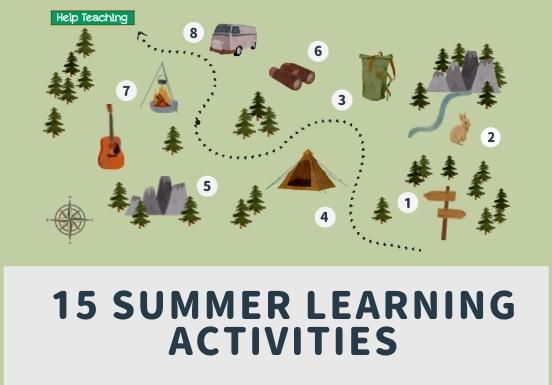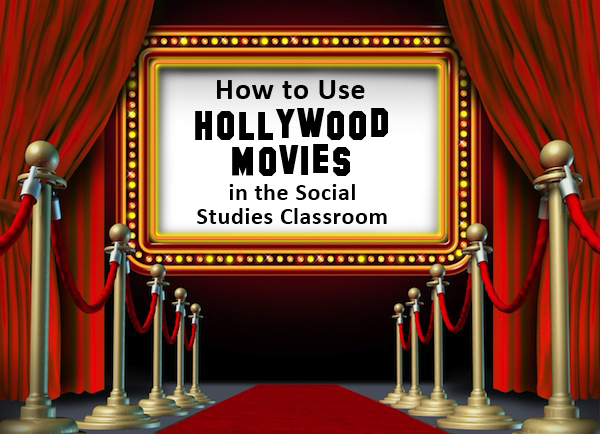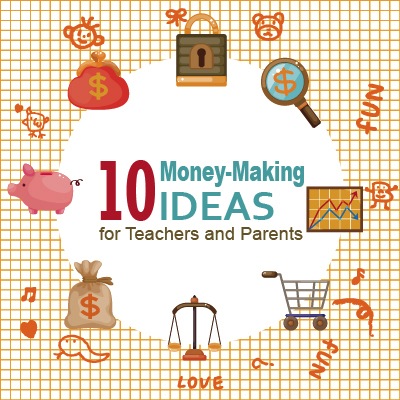Currently Browsing
Posts Tagged ‘ activities for children ’
Fun Daily Activities for Earth Science Week
- 1 October //
- Posted in For Parents, Teaching Resources //
- Tags : activities for children, earth science, STEM
- Comments Off on Fun Daily Activities for Earth Science Week

Earth Science Week is October 12-18, and it is the perfect time to show our appreciation for our home planet! With our Activities for Earth Science Week, each day of the week focuses on specific geoscience-themed celebrations. To help you and your students partake in this year’s events, we have put together a list of activities for each day of Earth Science Week.
Activities for Earth Science Week
Contests
STEM contests and competitions are a fun way to engage students in learning. The American Geosciences Institute offers several contests as part of Earth Science Week. Students in kindergarten through fifth grade may enter a visual arts contest, while an essay contest is open to students in sixth through ninth grade, and a photography contest and a video contest are open to all ages.
International EarthCache Day – Sunday
What better way to kick of Earth Science Week than with a scavenger hunt? EarthCaching is geocaching with a geoscience twist. Gather the kids, their phones or any portable devise with GPS technology, and head outdoors to find some educational treasures.
EarthCaching – An Educator’s Guide
The EarthCaching Educator’s Guide, put out by the Geological Society of America, provides all the background information, tips, and lesson plans required for parents and teachers to get their students started with earthcaching.
EarthCache Listings
Ready to find an earthcache? Visit geocaching.com to locate a nearby earthcache.
Earth Science Literacy Day – Monday
Earth Science Literacy Day focuses on the “Big Ideas” that we should all understand about earth science. Start by watching the Big Idea videos by the American Geosciences Institute. Then, why not take the opportunity to hook children on learning about our planet through reading? Below are a few of our favorite fiction books that feature geoscience themes. Most of these books complement Big Idea 6: Life Evolves on Earth and Big Idea 8: Natural Hazards Affect Humans!
Saturday Night at the Dinosaur Stomp by Carol Diggory Shields
Young children will enjoy the creative rhyming and variety of dinosaurs dancing it up at the dinosaur stomp. Adults will enjoy the way geologic time is interwoven throughout this rollicking story.
Dinosaurs Before Dark by Mary Pope Osborne
The beloved Magic Tree House series begins in the prehistoric past with Dinosaurs Before Dark. Early readers that have already started the series can skip the later geo-themed books, Vacation Under the Volcano or Earthquake in the Early Morning.
I Survived the Destruction of Pompeii, AD 79 by Lauren Tarshis
Older elementary students who are fans of adventure and historical fiction will flip through the pages of this story about the eruption of Mount Vesuvius. Related books in this series include, I Survived the San Francisco Earthquake, 1906 and I Survived the Joplin Tornado, 2011.
The City of Ember by Jeanne DuPrau
What better way to appreciate what the earth’s surface offers us than to take it away? Middle school readers will want to keep the lights on and find out what happens when the power goes out in the underground city of Ember.
Ashfall by Mike Mullin
High school students who enjoy disaster fiction will be drawn into the post-apocalyptic world of Ashfall. However, in this novel, the force that destroys the earth as we know isn’t aliens or governments, it’s our very own Yellowstone supervolcano.
No Child Left Inside Day – Tuesday
Time to go outside! Geoscience happens outdoors, so take advantage of this day and get your students and children outside with these activities.
Outdoor Education Stations
Coordinate an outdoor geoscience activity with a local earth science organization or setup education stations in your own backyard or school grounds.
Every Kid in a Park
If you teach or know any fourth grade students, take this day to get them signed up for the Every Kid in a Park program. The pass allows all U.S. fourth grade and home-school equivalent students and their families to visit hundreds of national parks, forests, and wildlife refuges for free. Bonus, the pass is good through the end of August, making it the perfect motivational tool for getting outside all year long!
Earth Observation Day – Tuesday
Take advantage of Earth Observation Day by engaging your students in practical applications of Earth Science data. Introduce your students to remote sensing with one of these lessons or activities or connect with a remote sensing scientist. Visit the Earth Observation Day website to get started!
National Fossil Day – Wednesday
If you are fortunate enough to have fossils on hand for students to examine, then today is the day to do so! If not, don’t worry, students can still participate in National Fossil Day with these activities.
Online Fossil Activities
Take students on an interactive adventure to the past without leaving the classroom with the Fossil Mysteries interactive. View fossils on exhibit at the Smithsonian’s National Museum of Natural History with the NMNH virtual tour. Explore online paleontology games and activities from the American Museum of Natural History. Try our free Fossils online lesson too.
Art and Photography Contest
Get creative by entering the National Fossil Day Art Content. The winning submission for each age group will be featured on the official National Fossil Day website.
Geoscience for Everyone Day – Thursday
How do we manage our mineral resources? Can we predict natural hazards? Could we survive on Mars? These are all issues geoscientists grapple with on a daily basis. Geoscience for Everyone Day is set aside for students to learn about geoscience careers.
Career Exploration
Allow your student to explore future career paths today. Science Buddies offers a great collection of job overviews and education and training information for those interested in Earth and Environmental Science careers. PBS’ Dragonfly TV features videos about Real Scientists, including an ocean scientist, meteorologist, marine geologist, and paleontologist.
Geologic Map Day – Friday
Geologic Map Day is dedicated to the important role geologic mapping plays in society. Geologic maps tell us much more than the location of roads and landmarks. Instead, they tell us about the history of the earth below our feet – the types of rocks and their ages, fault lines, and folds, all essential information for land-use planning.
Learn About Geologic Maps
For those unfamiliar with geologic maps, a primer is in order. Start by reading the Geologic Maps site by the US Geological Survey and the National Parks Service, then, explore the One Geology Portal.
Interpret a Geologic Map
Get hands-on and try interpreting a geologic map. Okay, it’s not quite that simple, but there are some excellent tools and lessons available. Start with the Visible Geology interactive, What’s Under My Feet, Geologic Maps and Groundwater, or Geologic Maps & Earthquakes.
International Archaeology Day – Saturday
Earth Science Week wraps up with International Archaeology Day, the perfect opportunity for families to experience the real-world intersection of geoscience and history.
Attend an Archaeology Day Event
The Archaeological Institute of America’s website has an interactive map and searchable database of Archaeology Day events happening around the world. Chances are there is a family-friendly tour, open house, fair, or exhibit near you.
Join a Dig!
Some archaeological sites allow volunteers to join in the dig free of charge. Search for potential volunteer opportunities here. If you and your students can’t participate in a dig, then go virtual with InteractiveDigs.com.
Looking for more ways to learn about planet Earth? Visit HelpTeaching.com and try our free Earth Science printables and lessons.
15 Summer Learning Activities for All Ages
- 17 June //
- Posted in For Parents, Teaching Resources //
- Tags : activities, activities for children, summer
- Comments Off on 15 Summer Learning Activities for All Ages
Summer’s here! It’s time for fun in the sun, family vacations, and… learning. While you want to give your kids a chance to relax, you don’t want them to lose all they learned during the school year. To help keep their minds sharp, incorporate some learning into their summer activities. Not sure where to start? We’ve got plenty of ideas to help your kids learn during the summer while still having fun! See our picks of summer learning activities below.
Elementary School
Give your elementary student a chance to have some hands-on fun this summer.
Head Outside

Start by getting out of the house and observing the world around you. Set up a scavenger hunt and have your kids scour the neighborhood in search of certain colors, sights, or sounds. Draw a map and see if they can navigate their way from point A to point B.
Explore Science
While you’re outside, take some time to explore the world of science. Talk about how the flowers boom and the animals that you see. Discuss the weather and notice changes in nature when it rains. For more ideas, try some of these science exploration ideas.
Visit the Library

Stop by your local library and give your kids a chance to look for some new books to read. Look for books by favorite authors or head to the non-fiction section and check out books on your child’s current favorite topic. Need some book suggestions? Our Black History Month Reading List offers a few titles to get kids started. Once they’ve found their books, encourage them to read on rainy days or take along a book when you head to the beach or the park.
Play Online Games
When you’re taking a break from laying in the sun or playing at the park, let your kids sit down at the computer and play some games. For both math and reading games, check out Funbrain.com or head to Math Game Time for some math-based play. The websites for your child’s favorite TV shows also often have fun, educational games for them to play. For more games, check out the sites found on our list of free education websites also offer plenty of free games and other fun learning activities for kids to enjoy.
Build their Character
Who says all learning has to be academic? During the school year, your child’s teacher and friends have a big influence on her life. Use the summer to build some key character values. These values will help them when they face conflicting viewpoints and character trials during the school year. You can work on building manners by having a dinner party, helping out others by volunteering, and asking “what would you do?” questions that incorporate scenarios related to honesty, respect, and other character traits. For older elementary and middle school students, you can incorporate some of the resources found in this blog post on character education.
Middle School
Pull your middle schooler away from the video games and phone and have some educational fun.
Read a Book
Your middle schooler isn’t immune from reading a book either. While he may not want to be caught dead at the library, you can still pick up a few books and make him set aside some time to read every day. If your middle schooler doesn’t like reading, choose a few graphic novels or look for non-fiction books that focus on his current interests. Check out our social studies summer reading suggestions to get him started and let him learn a bit about history while he reads.
Conduct a Science Experiment
Have some fun with science experiments this summer too. The kitchen offers a great place to start and gives your pre-teens and teens a chance to learn how to cook at the same time. Science Buddies offers a large selection of cooking & food science fair activities. These free science websites offer plenty of experiments to last the entire summer. If you’re ambitious, organize a neighborhood science fair and get all of the other kids on the block involved in conducting experiments too.
Get Online

Chances are your middle schooler will want to spend most of the summer on the computer or her phone talking to her friends. Let her go online, but encourage activities beyond socializing, such as visiting some of the top Free education sites. Encourage your middle schooler to build a new skill, such as learning how to code at Code.org or donate to charity while building vocabulary skills through websites like Free Rice.
Work on Executive Functioning Skills
The summer offers a great chance to build some skills that will help your middle schooler succeed when school starts back up again. Work on some of the same executive functioning skills that teachers work on during the school year, such as setting up a routine and using a planner to help keep your middle schooler organized.
Take a Trip
For your family vacation, let your middle schooler do the navigating and build map-reading skills at the same time. Can’t afford a vacation? Bring some maps into your home and plan a dream vacation anyway.
High School
Don’t let your teen sleep all day this summer.
Watch a Movie
Getting your teen out of bed can be enough a challenge during the summer. Give in and let him spend time on the couch watching educational movies. Try out some of these movies about historical events or some educational YouTube channels.
Conduct Research
Use the summer as a chance to get your teen to explore some of his or her interests through mini research projects. Explore a specific period of history, look further into a concept they discovered in a movie, or just encourage them to find the answers to the questions they have on their own.
Enlighten their Devices
If you can’t pull your teen away from his phone this summer, make the phone more educational. Add educational apps or even force your teen to learn before texting or using Instagram and Snapchat with an app such as StudyLock, which requires teens to answer academic questions before using their devices. You can also encourage learning through silly apps.
Volunteer
Get your teen out of the house and do something to help others. The summer is full of volunteer opportunities. Your teen can work with a summer camp, help out at a food pantry, go on a mission trip, or even just do some yard work for elderly neighbors.
Make Some Money
Of course, summer is also a great time for your teen to make some money. Getting a job will teach your teen about managing money, working with others, and building real-world skills. If a traditional job, such as working at a grocery store or fast food restaurant, doesn’t appeal to your teen, encourage her to get creative. Have a yard sale, sell a craft, or start your own family business. If you’re home with your teen all summer, use your free time to make some extra money too with these money-making ideas.
Have more ideas for keeping kids learning during the summer? Share them in the comments.
For more ideas, we suggest 100 Fitness Activities for Families and 100 Summer Activities for Kids.
3 Tools to Help Kids Learn Over the Summer
- 15 June //
- Posted in For Parents, Teaching Resources //
- Tags : activities for children, summer activities
- Comments Off on 3 Tools to Help Kids Learn Over the Summer
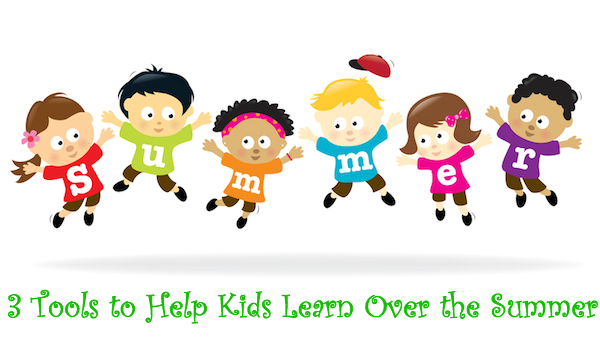 Learning can take place anywhere, not just in the classroom. Summertime offers many opportunities for kids to gain knowledge. You can help them learn by introducing them to three simple tools designed to get them interested in learning, even if they don’t realize that’s what they’re doing. Let’s dive into our tools to help kids learn over the summer!
Learning can take place anywhere, not just in the classroom. Summertime offers many opportunities for kids to gain knowledge. You can help them learn by introducing them to three simple tools designed to get them interested in learning, even if they don’t realize that’s what they’re doing. Let’s dive into our tools to help kids learn over the summer!
Our List of Ideas to Help Kids Learn Over the Summer
1. Ask Questions
Sometime during the toddler years, kids go through a “why” phase. They use the question “Why?” to help them figure out the world and everything in it. Unfortunately, many kids quickly grow out of that stage. To help kids learn over the summer, re-introduce them to the art of asking questions. It may seem annoying to have a child who is constantly asking how and why things happen, but when you realize those questions help them learn, it’s much easier to handle.
To help kids learn to ask questions, start by asking questions yourself. For example, if you’re at the zoo and see a zookeeper standing by an animal cage, take the time to ask the zookeeper a question. You don’t have to be at a zoo or museum to ask a question either. Ask questions of people all around you – your mechanic, the teller at the bank, the person stocking shelves in the grocery store. Even if you already know the answer to some of the questions you ask, you’ll show your children how easy it is to ask questions on their own. They’ll also discover that people are usually more than willing to answer the questions they ask.
2. Introduce them to Experts
When it comes to asking questions, one of the best places to find an answer is an expert on the topic of the question. The summer is a great time to help kids gain access to experts in many different career fields, not only to ask questions, but also to observe them as they work. Since
kids aren’t in school all day, they have more time to see how different adults spend their time. While many jobs don’t aren’t ideal for having a kid underfoot, some workplaces may allow children to shadow
a family member or close family friend for a day. Spending a day on the job can help kids learn more than simply reading a book or watching a video. It also gives them access to multiple experts in an industry and many of them will be ready to teach kids what they know.
When it comes to introducing kids to experts, think beyond careers and focus on interests and hobbies, too. For example, if your child is interested in the Civil War, see if you can set up an interview with a local Civil War reenactor. If your child wants to become a stronger swimmer, contact the swim team of a local college and see if a student would be willing to sit down with your child and give him some advice. Many adults who have hobbies would be more than happy to
take some time to sit down with your child and share about their interests.
Don’t forget about classes either. Many groups hold special classes during the summer. If your child is interested in cooking, for example, you may find a cooking class taught by a local chef. If your child likes sports, look for a sports camp that features a professional athlete or coach. These classes often cost money, but the cost is worth it if your child gets to interact
with someone at the top of their field.
3. Watch Videos
Of course sometimes your local area won’t offer special summer classes or experts that are of interest to your child. Thankfully, kids have the internet. Online they can find tons of videos related to their interests, many of them featuring some of the top people in the field. For example, TED Talks and Big Think have been known to feature some of the world’s greatest scientists and thinkers. Websites such as Top Documentary Films also can help kids learn by allowing them to access documentaries for free.
Since it’s summer, you may not want your kids sitting in front of the computer or TV screen all day. That’s where videos from sites like YouTube come in handy. Many YouTube channels (such as these channels for social studies) contain short videos designed to help kids get snippets of knowledge. A simple search for how-to videos can also help kids pick up a new skill by watching short videos. Maybe this summer they’ll learn to play the guitar, take ballroom dancing lessons, or discover how to make homemade ice cream. With millions of how-to videos on YouTube, kids can learn almost anything.
Sure, you want your kids to relax during the summer, but you don’t want them to stop learning. By connecting these tools with other summer learning activities you can ensure kids are being filled with knowledge over the summer.
For more resources to get kids learning on their own this summer, share our Ultimate Guide to Free Online Self-Learning for Kids, which is full of free videos, courses, and other materials to help kids explore their interests and find answers to their most pressing questions.
What tools do you use to help kids learn over the summer? We’d love to hear your ideas!
Social Studies Summer Reading Suggestions
- 7 June //
- Posted in For Parents, Teaching Resources //
- Tags : activities for children, parenting, reading list
- Comments Off on Social Studies Summer Reading Suggestions

The summer months bring relief and joy for students, but also lots of free time to be filled. There is no better way to spend these hours and days than with a book, especially one that educates. Below are book recommendations based on age and genre that will help keep your child or student busy and engaged throughout the summer.
Disclaimer: This post contains affiliate links and we may earn a small commission off any books purchased. However, all recommendations are our own.
Our Suggestions for Social Studies Summer Reading
Kids
Activity Book: “The Complete Book of U.S. History”
This book clocks in at over 350 pages and is chock full of exercises and activities to keep young minds sharp. (Ages 8 and up)
African-American Studies: “What Color is My World?: The Lost History of African-American Inventors” by Kareem Abdul-Jabbar and Raymond Obstfeld
NBA Hall of Famer Kareem Abdul-Jabbar writes of obscure African – American inventors in this well-illustrated story. (Ages 8 and up)
Presidential: “So You Want to Be President?” by Judith St. George
Does your little one ever wonder what it takes to become president? St. George chronicles every president in an interesting and humorous manner, accompanied by wonderful illustrations. (Ages 6–8)
Biography: “The Story of Ruby Bridges” by Robert Coles
The story of the first African American child to integrate Frantz Elementary School in New Orleans. (Ages 4-8)
Culture: “Homes Around the World” by Max Moore
Learn about different and unusual residences around the world. (Ages 5–7)
Teens
Historical Fiction: “The Boy in the Striped Pajamas” by John Boyne.
This acclaimed book introduces the Holocaust in a gentle manner and opens the door to discussion about such a sensitive topic.
Mystery: Chasing Lincoln’s Killer” by James L. Swanson.
This is a young adult version of “manhunt”, the same author’s account of the search for President Lincoln’s assassin. “Chasing Lincoln’s Killer” uses trial manuscripts and interviews to build a compelling and completely true thriller.
US History: “Don’t Know Much About History” by Kenneth C. Davis
This updated edition of the bestseller that answers all of your questions about American history in a very entertaining way.
Current Events: “I am a SEAL Team Six Warrior: Memoirs of an American Soldier” by Howard E. Wasdin and Stephen Templin
Learn the grueling training involved in joining the unit who found Osama bin Laden in this firsthand account from former Team Six member and author, Howard Wasdin.
World History Compilation: “A Little History of the World” by E.H. Gombrich
With illustrations on every page, Gombrich brings history to life for young adults.
The summer allows students to learn at their own pace and explore topics that interest them. Interesting and educational books are just the recipe to feed a hungry mind. You can also get kids interested in Social Studies websites and movies to help keep them learning throughout the summer.Got other suggestions for this list? Share them with others by commenting below.
10 Activities to Celebrate World Oceans Day
- 1 June //
- Posted in Teaching Resources //
- Tags : activities for children, summer activities, world oceans day
- Comments Off on 10 Activities to Celebrate World Oceans Day
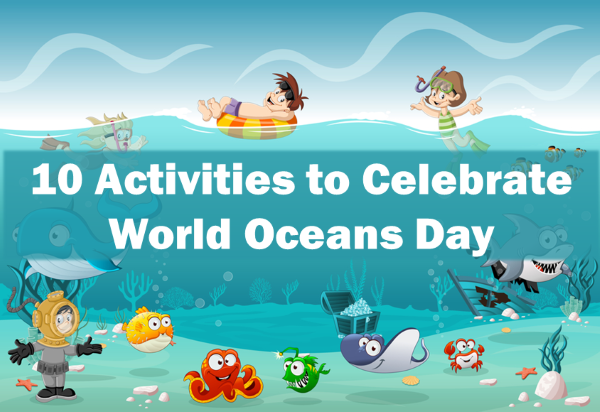
Each year on June 8th, we observe World Oceans Day to draw attention to how important our planet’s seas and oceans are to life and livelihoods. Did you know, for example, that the up to 50% of our oxygen comes from the ocean? And if you thought rainforests were the most biodiverse ecosystems on the planet, think again – it’s actually our oceans, which makes sense since they cover 70% of the Earth’s surface.
So this World Oceans Day, help your students understand just how important it is to protect it, sustainably use its resources, and how we can benefit from learning more about it. So put on a blue shirt and forge ahead with these ten fun ways to celebrate World Oceans Day with your class or family.
1. Skipper Your Crew to a World Oceans Day Event
Check out World Ocean Day’s website to find out what events are going on in your area. You can also list your own events and learn more about youth initiatives. From art contests to film festivals to hands-on exhibits, there are ocean activities taking place around the world and students can discover a whole community of passionate youth working to protect our oceans for future generations.
2. “Fish are Friends, Not Food”
Who doesn’t love battered or crumbed fish, juicy mussels, moreish shrimp, and the versatility of tuna? Did you know that the oceans are the main source of protein for a billion people around the world? That puts enormous pressure on fish stocks, the majority of which are overfished and in their populations in decline.
While this can all sound pretty depressing, you can teach students how to make informed decisions as consumers and teach their families how to be ocean warriors using their wallets at stores and restaurants. Discover which fish are the most eco-friendly to buy and consume. You can then do this worksheet on ocean zones so students know where the fish they buy is coming from.
3. Say No to Plastic
Plastics are one of the biggest threats to ocean health and one of the easiest things to change from a lifestyle perspective. Each year, trillions of pieces of plastic enter the world’s river systems and water ways and end up in the oceans. They slowly gather into gyres, some of which are bigger than the state of Texas.
Plastics in the oceans aren’t just a hazard to its inhabitants that eat it or get tangled up in it, but they break down into micro-plastics which then enter the food chain and we humans end up eating!
This year, teach your students about the impact of single-use plastics, like drinking straws and packaging, and the importance of recycling and responsibly disposing plastic. When done, you can then organize a beach clean up. If the ocean is too far away from you, remember, plastics can travel for hundreds of miles before entering the oceans, so even a plastic clean-up along rivers, streams, or your community will benefit the oceans.
4. Ocean Explorers
It’s much easier to protect something when you’ve got a connection to it. Google has an amazing feature called Google Ocean in which you can explore the vast waters much like street view has changed the way we explore areas of land. Discover images, locations, and other media with this this stunning collection.
If you’re able to, set your bearings to your local aquarium. Students of all ages will enjoy viewing and interacting with the amazing variety of sea life on display.
5. Where the Currents Go
The currents of the world play a huge role in the kinds of ecosystems and animals that are found in a region. First, teach your students about currents and use our Currents worksheet to reinforce their understanding. Then, for some extra fun and impactful awareness, take a look at Adrift.org. This amazing interactive website shows just how far plastics can travel in the ocean, and drives home the lesson that one’s mindless actions at home can have a big impact on others around the world. Challenge your students to predict the path of pollution before seeing where it actually lands up.
6. Sail Over to the Smithsonian
We love the Smithsonian and the wealth of information available for students and teachers. This World Oceans Day, check out its diverse collection of ocean-related lesson plans for educators. From the impact of oil spills, to light penetration, and marine environments, to name just some, there’s something for all subjects and all grades from K-12.
7. Dive into an Ocean-themed Reading Adventure
For landlubbers who can’t venture out to sea, dive into an ocean-themed book for a reading adventure worthy of the high seas. Get started with one of these nautical tales.
Nautical Novels and Seaworthy Stories
The Rainbow Fish by Marcus Pfister
Swimmy by Leo Lionni
Flotsam by David Wiesner
Mr. Popper’s Penguins by Richard and Florence Atwater (Worksheet)
Treasure Island by Robert Louis Stevenson (Worksheet)
Moby Dick by Herman Melville
Billy Budd by Herman Melville
The Pearl by John Steinbeck (Worksheet)
Kon-Tiki by Thor Heyerdahl
20,000 Leagues Under the Sea by Jules Verne
The Odyssey by Homer (Worksheet)
The Old Man and the Sea by Ernest Hemingway
8. Action Starts with Awareness
Ahoy! Teachers, students, and families can join an Ocean Guardian Program and plan a school or community conservation project, submit ocean-themed artwork, stories, or poetry, and even become involved in diving!
9. A Good Day for the Beach
Head to the beach! What better way to celebrate World Oceans Day then by digging in the sand, discovering tide pools, and surfing the waves? It’s a perfect opportunity for students to explore the environment while also teaching them the importance of not interferring with the local ecosystem by removing shells, catching small creatures, or turning over rocks.
10. There’s No Place Like Home
Movies like Finding Nemo are often box-office hits and seen by millions of people around the world. Unfortunately, while creating awareness, it can also increase the demand for the creatures featured in the films. Without careful research, would-be hobbyists can end up fuelling the illegal capture and trade of wildlife or products such as shells and coral, or worse yet, killing creatures through lack of knowledge.
Marine creatures belong in their natural environment and should only be kept by experts. Rather than buy marine creatures for enjoyment at home, visit a local aquarium that’s contributing to research and protection.
Lessons and Resources
If you are swamped with lesson planning, check out Help Teaching’s collection of pre-made, ocean-themed worksheets. Or, have your students try our online lessons on Ocean Vocabulary Words, Ocean Zones, Tsunamis, or Tides. Our friends over at Kidskonnect.com has a large collection of facts and worksheets for kids about Oceans too!
Have other suggestions for celebrating World Oceans Day with students and children? Share them in the comments! Read The Ultimate Guide to Teaching Science for more ways to invigorate your science curriculum and teaching.
5 Summer Science Exploration Ideas for Kids
- 29 May //
- Posted in For Parents, Teaching Resources //
- Tags : activities for children, science, STEM, summer
- Comments Off on 5 Summer Science Exploration Ideas for Kids
 Science surrounds us and summer offers the perfect time for families to explore science in action. Avoid the summer slump and try some of these suggestions for summer science adventures with your child. Most of these activities are low-cost or free, but be sure to check with your local library before heading out to learn about free and discount passes to museums and other local attractions.
Science surrounds us and summer offers the perfect time for families to explore science in action. Avoid the summer slump and try some of these suggestions for summer science adventures with your child. Most of these activities are low-cost or free, but be sure to check with your local library before heading out to learn about free and discount passes to museums and other local attractions.
Our List of Summer Science Ideas
1. Participate in a Citizen Science Project
Science is collaborate by nature, so join in and lend a hand by participating in a citizen science project. Project participants support scientific research by:
- Classifying the shapes of galaxies (see Galaxy Zoo),
- Extracting weather data from old whaling logbooks (see Old Weather – Whaling),
- Collecting ants (see School of Ants),
- Monitoring monarch larva populations (see Monarch Larva Monitoring Project).
These are just a few of citizen science projects looking for volunteers and many welcome help from children working with the guidance of an adult. Search for other citizen science projects at Zooniverse and SciStarter.
2. Become a National Park Service Junior Ranger
With parks from Maine to California and everywhere in-between, the National Park Service offers an affordable option for hands-on summer science fun. Fourth grade students qualify for free annual park passes through the Every Kid Outdoors program. The Junior Rangers Program gives kids the opportunity to explore nature, attend ranger guided programs, and complete activities for each park. If your budding park ranger completes a Junior Ranger Program, each park offers a patch or badge and a certificate of completion. Can’t visit a particular park? Visit the NPS’s on-line WebRangers page.
3. Visit a Science Center
There are many fabulous science museums that offer kids access to interactive learning opportunities. For those fortunate enough to be within driving distance to a NASA center, consider a visit. Learn about space exploration, aeronautics, and ongoing missions and discoveries. Many of the centers, including Johnson Space Center in Houston, TX, Kennedy Space Center in Cape Canaveral, FL, and the Jet Propulsion Laboratory in Pasadena, CA, welcome visitors and offer tours. If you can’t travel to a visitor center, then be sure to visit NASA Wavelength and explore the vast collection of educational resources NASA has to offer.
With centers across the nation, the Audubon Society provides outdoor adventure for all ages. Visit a sanctuary, go on a hike, and explore the local lands and wildlife. Many centers offer nature-themed programs designed exclusively for children and families as well as summer camps. Centers are open to the public, but those with memberships may visit for free and receive discounts on programs and camps. Find an Audubon Center near you.
4. Try Hands-On Science Activities
Hands-on science activities at home are a great way to have some summer fun, spend family time together, and even learn a little something new. Science at home is affordable and typically can be conducted with household objects and resources. Follow your child’s lead and try experiments related to his or her interests. Get started with these science activities for kids or browse this collection of home science activities from Scientific American.
5. Star Watch
Grab a blanket and the bug spray and head outside for some star gazing. If possible, get away from light pollution, you will be amazed at what you can see once your eyes adjust to the dark on a clear night. Bring a star chart and try to locate a few stars, planets, constellations, and galaxies. Use binoculars to identify surface features of the moon. If that isn’t spectacular enough for your aspiring astronomer, try counting the number of “shooting stars” during a meteor shower. August’s Perseids meteor shower is a great one to enjoy on a warm summer evening. Check out this year’s not-to-miss celestial events to watch with kids.
Above all, be sure to get your kids outside to get some fresh air and soak up some vitamin D!
Looking for more ideas for summer fun with your children? Be sure to read 100 Summer Activities for Kids!
11 Engaging Earth Day Activities for Kids
- 13 April //
- Posted in Teaching Resources //
- Tags : activities for children, earth day, science, STEM
- Comments Off on 11 Engaging Earth Day Activities for Kids
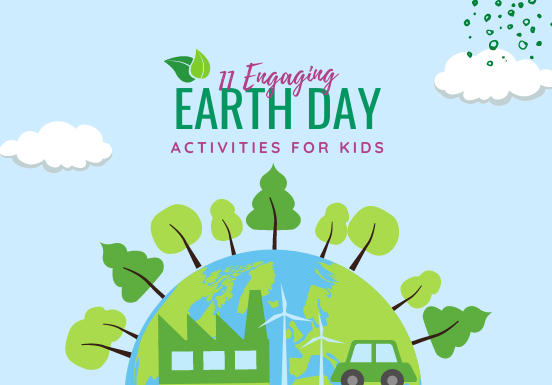
Earth Day is April 22. Earth Day celebrations aim to raise public awareness on environmental issues. Learn more about the day, fun activities for kids, and resources available!
Since 1970, Earth Day has been celebrated with the hopes of promoting ways to help keep our planet healthy. Today, our waterways are less polluted and our air is cleaner, yet there is still much work to be done before we can consider ourselves a sustainable society. This year, engage your students or children with one of these eco-friendly activities on Earth Day or the weeks surrounding it.
Activities for Children – Kindergarten to Grade 6
Plant a Tree
It may seem cliché, but planting a tree is a simple act that helps the environment and gets children outdoors enjoying the natural world on Earth Day. Coordinate with your school a place on the grounds where your class can plant a tree or check with your local conservation board for a public location. Apply for free trees through organizations like Trees for Schools (UK only) and Trees for Wildlife or by having students write to local nurseries.
Raise a School Garden
April is National Garden Month, making Earth Day the perfect time to plant a school garden. Gardens are an excellent way to get kids moving, encourage healthy eating, and incorporate project-based learning into your curriculum. A school garden takes time and commitment, but in planning and raising a garden, you will sow seeds that will help your students reap a lifetime of rewards! Get started with these school gardening tips.
Let the trash pile up!
During the week leading up to Earth Day, arrange with the custodian not to remove the trash and recycling from your classroom. On Earth Day, have your students weigh the trash and recycling they generated (weigh trash separately from recycling). Over the next week, challenge your students to toss and use less, plus recycle more. After a week, have students weigh the trash and recycling again and calculate the decrease (hopefully!) in trash weight and increase in recycling weight. Extend the lesson for older students and have them calculate percent increase and decrease as well. Get started by assigning the lessons Reduce, Reuse, Recycle and The Trash Patrol, then read our America Recycles Activity Guide for more ideas.
Walk to School
It is good for the environment and our children’s health. More and more schools are planning annual walk- or bike-to-school days. Why not plan one for April 22 or use Earth Day to have your students start planning for National Walk to School Day in May? Visit the Walk & Bike to School website for more information on getting started.

Declare April 22 Waste-Free Lunch Day
With the help of your class and the EPA’s Pack A Waste-Free Lunch site, make Earth Day a school-wide commitment to reducing the mounds of garbage generated during typical school lunch. Have your class coordinate with administrators and cafeteria workers and help spread the word to students and parents about what can be done to minimize lunch waste.
Get your students excited for Earth Day by engaging them with these interactive lessons on Climate Literacy and Environmentalism by PBS Learning Media and with Help Teaching’s self-paced science lessons.
Activities for Teens – Grades 7 to 12
Participate in a Citizen Science Project
Engage your children or students in authentic science by participating in an eco-themed crowd science collaboration. There are numerous projects running that allow students to participate with adult supervision, including the environmentally oriented: The Lost Ladybug Project, and Globe at Night.

Take a Field Trip
What student doesn’t love a field trip? Plan an inexpensive day out by arranging tours of your local landfill, recycling center, wastewater treatment facility, and/or power plant (even better – visit a plant that uses renewable energy and one that uses a nonrenewable source). Yes, it will be dirty, hot, and smelly, but what better way for students to develop an understanding of where energy comes from and trash goes than to see it for themselves?
Host an Environmental Career Fair
Enlist your students in finding local professionals working in environmental careers to visit the school on Earth Day. Arrange for a career fair that allows students to hear about green jobs and discuss job duties with the professionals. Have students prepare questions ahead of time and write thank-you notes after.
Conduct a School Energy Audit
Challenge students to work in small groups to perform an energy audit of their school. Each group can audit energy use for a given building space like the classroom, cafeteria, gymnasium, or auditorium. Groups can share their results and compare their findings, then use the data to prepare an energy action plan to present to the school administration. The National Wildlife Federation and Green Education Foundation both offer resources for energy audit projects for students.
Build a Rube Goldberg Machine
Ask your students to bring in a variety of cleaned items from their home recycling containers during the week leading up to Earth Day. On April 22, divide your students into teams and task them with designing and building a machine that completes a simple eco-friendly task such as turning off the lights or watering a plant. Provide basic materials, like string and wire, to aid in construction. Be sure and have your students demonstrate their machines to an audience and see if their projects can be displayed in the school lobby or library. Find free lesson plans and ideas at RubeGoldberg.com.
Launch a Project-Based Learning Unit
Spring has sprung and students are anxious to get outside, making Earth Day the perfect time to embark on an environmentally focused project-based learning (PBL) initiative. BIE.org offers extensive PBL resources for teachers and students.
Be sure to visit Help Teaching’s Earth Science Printables and Lessons for free environmental science resources to use on Earth Day and year-round!
Additional Online Resources
- KidsKonnect has worksheets for Earth Day and Planet Earth, Sequoia Trees, Terrace Farming, Oceanography, Forest Fires, Gardens, Weather, Swamps, Wind Energy and many more resources related to Earth and environmental science
- BusyTeacher has loads of resources for Earth Day here
- EarthDay.org, the world’s largest recruiter of the environmental movement, working in over 190 countries, presents us with ways to drive positive action for our planet. This year’s theme is “Invest in our Planet“. Click here to find out how you can participate.
- The National Education Association has eco-friendly lessons for Earth Day and every day
- Bring environmental justice and awareness into your classroom with these videos, articles, and lesson plans from PBS Learning Media
- ReadWriteThink will help your students research some environmentalists who have made major contributions to our planet
- Here are 5 Distance Learning Earth Day Lessons Your Students Can Do At Home from Population Education
- The U.S. Environmental Protection Agency has many free resources for teaching about the half-century history of Earth Day
- Celebrate Earth Day on April 22, 2021 at this family-friendly online festival honoring our planet presented by New York’s American Museum of Natural History
The 50-year legacy of Earth Day can be effectively transmitted with these resources. Hopefully, in another 50 years, your students will have witnessed the solutions to many of our planet’s environmental problems. Happy Earth Day!
Image source: Unsplash
Ultimate Guide to Crafts for Kids
- 24 March //
- Posted in For Parents, Fun Facts //
- Tags : activities for children, parent resources, teacher resources
- Comments Off on Ultimate Guide to Crafts for Kids
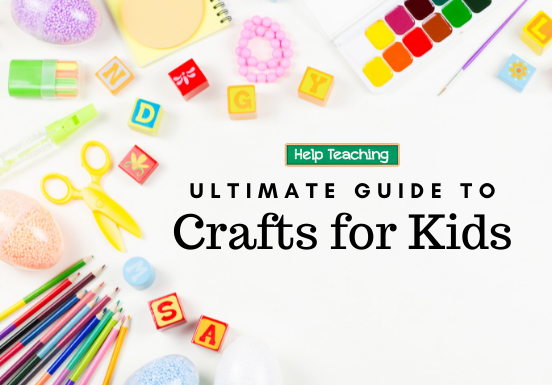
Kids love crafts (and many grown-ups do too). Sites like Pinterest are full of craft ideas for kids, but sometimes you don’t feel like wading through all of the pins. When you’re short on time or aren’t quite sure what you’re looking for, there are plenty of craft sites ready to help you out. Whether you want to celebrate National Craft Month in March, find a craft to go along with a lesson, or just do a craft with the kids, we’ve rounded up a collection of the best craft sites to help you find the perfect craft for kids. With over 50 kid-friendly resources, you’ll be getting crafty in no time!
See Our Ultimate Guide to Crafts for Kids
General Crafts
Many craft sites cover all subjects and seasons. These are some of our favorites both for the amount of craft ideas they offer and the quality of the ideas they provide.
 Red Ted Art’s motto is “Bringing Color & Art to Children’s Hearts.” This site is full or really neat ideas to encourage children to develop their creative side. Crafts are organized by category and range from making gifts to designing your own board games.
Red Ted Art’s motto is “Bringing Color & Art to Children’s Hearts.” This site is full or really neat ideas to encourage children to develop their creative side. Crafts are organized by category and range from making gifts to designing your own board games.
Busy Bee Kids Crafts organizes its craft ideas by time of year, category, and material. For example, if you have a wealth of empty toilet paper tubes, you can see a list of crafts that will help you use them up.
Enchanted Learning’s crafts section includes craft ideas for nearly every holiday and category. The crafts include a mix of printables and simple paper-based crafts. Most are appropriate for preschool and early elementary school.
DLTK’s Crafts for Kids is another quintessential crafts site, with a large selection of crafts for preschool and early elementary school. One section of the site is entirely devoted to printable crafts, which are ideal for those who want simple crafts with little mess.
First Palette includes a large selection of crafts searchable by theme, occasion, and age. Crafts range from toddler to ages 9 and up. While the site does have some printable crafts, many are slightly more involved crafts that will require grown-up participation.
Crayola has a great selection of crafts that can be made with Crayola projects. You can filter by age (12 months-12+ years), category, and color.
Storybook Crafts and Favorite Characters
Younger kids love to create crafts related to their favorite stories and characters. These sites take some of the most popular picture books and cartoon characters and pair them with great crafts for kids.
 Kids Activities Blog has gathered up 100 crafts inspired by children’s books. These include crafts from books such as The Very Hungry Caterpillar and Knuffle Bunny.
Kids Activities Blog has gathered up 100 crafts inspired by children’s books. These include crafts from books such as The Very Hungry Caterpillar and Knuffle Bunny.
No Time for Flashcards features a list of 25 books with crafts to match. Find a book you want to read with young kids and a relevant craft beside it. It can’t get much easier than that.
The Picture Book Professor offers many holiday and seasonal booklists that are accompanied by relevant crafts for kids.
PBS Kids crafts for kids page features crafts for many of kids’ favorite PBS shows, such as Peg+Cat, Sesame Street, and Daniel Tiger’s Neighborhood. Many of the crafts are involved and require grown-up participation.
Disney Family offers many different craft ideas featuring favorite Disney characters. Many of the crafts are designed to be completed by families, which means they have steps that will be difficult for little kids.
Bible Crafts
Bible crafts can help kids learn more about key events and lessons in the Bible. These sites are perfect for Christian homeschoolers, Sunday school teachers, and parents who want to bring Bible lessons into the home.
 DLTK’s Bible Crafts features a large selection of craft ideas organized by animals, general Bible crafts, Old Testament crafts, and New Testament crafts. Their offerings include printable crafts and many crafts that use items found around your home.
DLTK’s Bible Crafts features a large selection of craft ideas organized by animals, general Bible crafts, Old Testament crafts, and New Testament crafts. Their offerings include printable crafts and many crafts that use items found around your home.
Danielle’s Place offers a massive selection of Bible stories and crafts for kids. Crafts are organized alphabetically by story. Each story is also accompanied by fun games.
Christian Preschool Printables focuses on easy-to-use printable crafts for kids. Crafts are organized by Old Testament, New Testament, and Holidays.
Meaningful Mama created a list of 100 Best Bible Crafts for Kids. The crafts are organized by major stories in the Bible.
Edible Crafts
With these edible crafts, you can have your crafts and eat them too. These sites offer crafts for a range of ages, from young kids who like to play with their food to older kids who are starting experiments in the kitchen.
 Edible Crafts includes a large assortment of edible crafts for kids and adults. Many of the crafts are focused on special occasions.
Edible Crafts includes a large assortment of edible crafts for kids and adults. Many of the crafts are focused on special occasions.
Kinder Art shares a solid collection of recipes and edible crafts for kids. Many are simple enough to made by younger kids, with some grown-up supervision.
Cute Food for Kids features many neat ideas to help parents make kids’ food playful and fun. While many of these ideas are designed for parents, kids can help with the process.
Imperial Sugar offers many edible art projects that incorporate sugar and also includes fun science experiments as well.
Fun Family Crafts has an extensive archive of edible crafts, including some inspired by kids’ favorite movies.
Science and Nature Crafts
Science and nature crafts are a great way to get kids to have fun while learning more about the world around them. These sites include crafts made from materials found in nature and science experiments to help kids learn more about the world of science.
 Tinkerlab features a variety of crafts and other projects designed to get kids thinking. Its offerings include many crafts related to science and nature that are great for upper elementary school.
Tinkerlab features a variety of crafts and other projects designed to get kids thinking. Its offerings include many crafts related to science and nature that are great for upper elementary school.
Science Kids offers many fun science experiments and crafts designed to help kids learn more about how the world works. Ideas range from making eggs float to building parachutes.
The Craft Crow features crafts designed to help kids learn about science while being creative as well. Many of the activities repurpose the same materials in multiple ways.
32 Awesome Things to Make with Nature from Buzzfeed is full of clever craft ideas. While many of the ideas are designed for adults, they can easily be adapted to be fun for kids too.
Activity Village offers a nice selection of crafts designed to be used with leaves, pine cones, and other easy-to-find objects from nature. Many crafts can be enjoyed by younger kids too.
National Geographic features a selection of crafts designed for kids in elementary and middle school. Many of the crafts are designed to go along with National Geographic articles or programming.
Recycled Crafts
Rather than wasting paper and other items, why not make crafts from items you can find around your home? Kids can have fun and help save the environment at the same time.
Education.com’s Recycled Crafts section includes tons of craft ideas, from using old Christmas lights to creating a classic tin can phone.
Fave Crafts shares its list of 1000+ Recycled Crafts. This extensive list features crafts for both kids and adults and all of them use recycled items.
Planetpals is all about saving the Earth and it continues its mission through its collection of recycled crafts for kids.
Math Crafts
Sometimes right-brained students have a hard time grasping math. Bringing craft projects into the math classroom can help students grasp difficult concepts in fun ways.
 Lalymom offers a list of 20 different math activities activities that all use the same main material – craft sticks! These activities are designed for preschool and early elementary school and help kids learn a range of basic math skills.
Lalymom offers a list of 20 different math activities activities that all use the same main material – craft sticks! These activities are designed for preschool and early elementary school and help kids learn a range of basic math skills.
Nurture Store created a list of 100 hands-on, creative math activities for kids. Many of the items on the lists are crafts kids can complete. Activities are organized by skill, such as addition and subtraction and learning symmetry.
Artsy Craftsy Mom shows 15 different mesmerizing crafts that also integrate Math. Ideas include tessellations and colorful Fibonacci sequences.
We Are Teachers shares a list of 9 math art projects designed to help students love math. Ideas include musical fractions and place value pictures.
Social Studies Crafts
Craft projects can help kids experience the time period or event they’re learning about. Many of these sites offer projects that allow kids to make replicas of toys and tools found in history.
 The Crafty Cow is an arts and crafts website for kids and they feature a lot of easy to make crafts that will help you teach history at the same time.
The Crafty Cow is an arts and crafts website for kids and they feature a lot of easy to make crafts that will help you teach history at the same time.
A Book in Time includes many resources for teaching social studies, including pages of crafts and projects organized by periods in American and world history.
Quatr.us offers a “What Should I Do Today?” section with a variety of social studies crafts. The site also has tons of articles on many different social studies topics.
Gifts for Others
Rather than spending tons of money on holiday gifts, why not have kids make gifts for friends and family? These sites offer some great handmade gift ideas.
 FreeKidsCrafts.com has over 10 pages of crafts that kids can make as gifts for others. Ideas range from candy towers to glittery acorn necklaces. Many ideas are great for upper elementary and middle school.
FreeKidsCrafts.com has over 10 pages of crafts that kids can make as gifts for others. Ideas range from candy towers to glittery acorn necklaces. Many ideas are great for upper elementary and middle school.
101 DIY Gifts for Kids from Kids Activities Blog includes a large selection of ideas for both kids and parents to make.
101 Crafty Gifts to Make from Instructables is a list designed for adults, but many of the ideas could easily be made by older kids and teens as well.
40 Useful Gifts Kids Can Make is full of great crafty gift ideas. It includes gift such as handprint aprons and handmade bowls. Many will require help from a grown-up.
101 Handmade Gift Ideas Kids and Families Can Make from the Artful Parent is a great collection of crafty ideas. The crafts are organized by gift type, such as art gift, gifts for play, and gifts for the home.
Coloring Pages and Cut-Outs
Sometimes instead of making fancy crafts, kids just like to color. Pick up cheap coloring books at the dollar store or print them out from these sites.
 KidsKonnect has dozens of free printable coloring pages for kids.
KidsKonnect has dozens of free printable coloring pages for kids.
Coloring.ws from DLTK is full of simple coloring pages organized by category and holiday. Print them out and let kids color away.
Crayola offers many free coloring pages, including pages featuring some of kids’ favorite characters, such as the Disney Princesses.
Educational Coloring Pages has thousands of coloring pages for kids featuring their favorite cartoon characters.
The Kidz Page has a large selection of printable and online coloring pages organized by category and holiday. They include many early elementary pages.
HelpTeaching.com’s Early Education printables feature coloring pages designed to help preschoolers learn their letters and numbers.
Craft Kits and Subscriptions
If even searching for craft ideas for kids is too much work, consider getting a subscription to a craft box or purchasing a craft kit.
 Kiwi Crate is a monthly subscription box that includes a different craft or maker project each month. It is designed for children ages 5-8, but the company offers other boxes for kids from ages 3-16.
Kiwi Crate is a monthly subscription box that includes a different craft or maker project each month. It is designed for children ages 5-8, but the company offers other boxes for kids from ages 3-16.
Green Kid Crafts features monthly subscription kits for kids ages 3-10. Each kit is focused around a different educational theme and comes with STEAM activities for kids.
Bramble Box is a pretend play and craft kit that is delivered to your door monthly. Kids will enjoy exploring and reading about a monthly theme, and then creating a craft related to it. Many themes relate to math, science, and social studies, so it’s educational too!
Science Buddies sells kits to help kids learn about science while making their own fun toys, such as vibrating robots and a magic bullet train.
Oriental Trading is known for its pre-made crafts for kits. Many of the kits come in multi-packs, which makes them great for play dates or classroom craft time.
Tips for Crafting with Kids
Before you start a craft project with kids, keep these tips in mind.
- Gather all of your materials in advance
The kids will be ready to get started right away, so you want to make sure you have everything ready to go.
- Be patient and flexible
It may take kids a long time to complete a step and they may not do it perfectly, but you need to step back and let them craft their own way and at their own pace. If their snowman comes out looking for like a snowball, who cares?
- Prepare for the worst
Crafts are designed to be messy. Cover your dining room table, put newspaper or plastic on the floor, and let kids wear a large paint shirt so you’re not as worried about the mess.
- Have fun
Why let your kids have all the fun? Summon your inner-child and have some fun getting messy and making the crafts with them.
Do you have a go-to craft site or a great craft idea with kids? How about tips for parents and teachers taking on a big craft project? We’d love if you shared it with us.
How to Turn Your Spring Break into a Learning Experience
- 18 March //
- Posted in For Parents, Teaching Resources //
- Tags : activities for children, holidays, parent resources
- Comments Off on How to Turn Your Spring Break into a Learning Experience
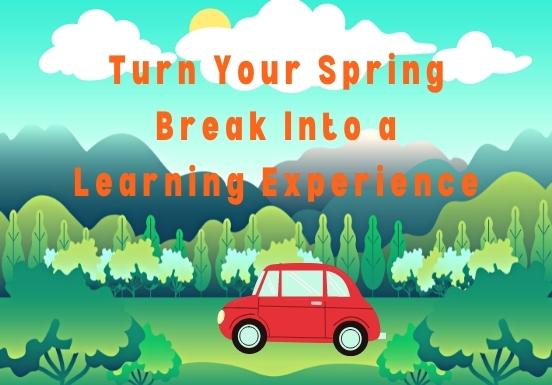
During spring break, many families try to squeeze in a getaway. One way to have a fun family adventure is to incorporate education into your trips. There are so many places across America that offer a terrific spring or summer-like atmosphere while opening your children’s eyes to the history of this country and other learning opportunities.
Museum Sleepover
Numerous museums across the country offer overnight excursions inside of their buildings! What better way to become acquainted with different aspects of culture and history than to sleep next to exhibits and artifacts?
Three different Smithsonian-affiliated museums in the Washington D.C. area offer sleepovers, with dates scheduled through the end of August. The American History Museum, Natural History Museum, and the Air and Space Museum’s Udvar-Hazy Center all offer overnight stays that include tours, games, crafts, and more.
For families in the Northeast, head over to Pier 86 on the west side of Manhattan and spend the night on the Intrepid! The Intrepid Sea, Air, and Space Museum offer fun activities, including a ride in a flight simulator!
The Field Museum in Chicago hosts “Dozin’ with the Dinos”, a nighttime exploration with museum scientists that make the exhibits come alive!
Living History Museums
There may be no better way to understand what bygone eras were like than to actually experience them. These attractions bring history to life by showing what daily life and major events were like in a specific period.
One of the best-known of these types of attractions is the world’s largest living history museum, Colonial Williamsburg. It features hundreds of reconstructed and historically furnished buildings, with costumed guides who tell stories of the people who lived there in the 1700s.
Columbia State Historic Park is a living gold rush era town. It contains “residents” in 1850s attire, and tons of exhibits, activities, and experiences you would find in a gold rush museum.
Connor Prairie Interactive History Park in Fishers, IN recreates life in a rural community in the 19th century. This attraction also offers a look at Native American life at this time. Kids will love the interactive nature of life on a prairie, as they can work as a farmhand, become a craftsman, or ride in a helium-filled balloon high overhead.
Landmarks
We’ve seen them on television, we’ve always meant to go there, but many Americans have not seen some of our most famous landmarks. The stories and the history behind these places and modern marvels are well worth the trip.
The Gateway Arch in St. Louis, MO is a magnificent architectural creation that also serves as a monument to Thomas Jefferson’s plans for American expansion and the role of St. Louis as a gateway to the west.
Mount Rushmore in Keystone, SD offers so much more than the breathtaking mountain sculpture of four of America’s presidents. Vacationers can learn about the natural history of the surrounding area, as well as methods used to sculpt the chief executives. There is also ample information available on the Native American tribes who called this area home.
It’s never too late to enjoy the springtime, and it’s never too early to refocus on education and learning. Make a last-ditch effort to get away and take advantage of all of the creative educational – and fun – opportunities our country has to offer.
Brain Breaks to Help Students Reset, Refresh, and Get Moving
- 10 March //
- Posted in For Parents, Teaching Resources //
- Tags : activities for children, study skills, teacher resources
- Comments Off on Brain Breaks to Help Students Reset, Refresh, and Get Moving
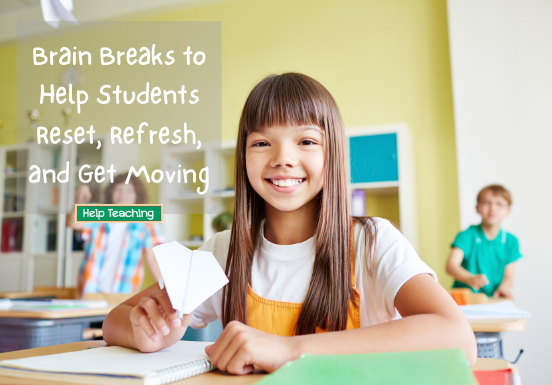
Let’s face it, learning can be overwhelming. With so much information coming in at once, sometimes students just need a break. That’s where brain breaks come in. Brain breaks are short, focused activities designed to help students recharge and refocus. Although typically used with preschool and elementary grades, brain breaks can be used with students of all ages. Keep reading to learn more about brain breaks to help students reset, refresh, and get moving.
Why Brain Breaks?
Brain breaks have found their way into thousands of classrooms around the world, and it’s not just because they’re fun. Research involving children’s brains shows that movement and exercise can improve behavior and academic performance in the classroom. That’s why you’ll often see preschoolers spinning in circles, climbing around, and touching things with their hands as part of their learning process. Other types of brain breaks, such as breathing exercises, also have benefits backed by research. For example, deep breathing exercises can help decrease the symptoms of ADHD and anxiety in children.
Types of Brain Breaks
The goal of brain breaks is to get students to step back, clear their heads, and give them a couple minutes to recharge. This can be done in multiple ways. Some common forms of brain breaks include:
- Physical movement
- Calming exercises
- Creative activities
- Engaging media
- Social interaction
While physical movement is the most common type of brain break used in the classroom, teachers can incorporate different types of brain breaks based on factors such as the time of day, the time of year, and their individual students’ needs.
Physical Movement
Research shows that students need to move throughout the day. Physical brain breaks get students out of their seats and give them a chance to get in a bit of exercise. Examples of physical brain breaks include:
- Singing a song with motions
- Reading a movement story
- Moving like animals
- Dancing to music
- Stretching
- Jogging in place
- Jumping jacks
- Play a game such as the Pirate Ship Game
Calming Exercises
Learning can be stressful, especially during testing season. Calming exercises help students release any anxiety and tension they have built up inside. They also teach students techniques for handling stressful scenarios in other settings. Examples of calming brain breaks include:
- Breathing exercises
- Guided imagery
- Listening to calming music
- Sitting in silence
- Yoga poses
Creative Activities
Creative activities give students the opportunity to exercise a different part of the brain. A lot of learning involves logic and reasoning. Bringing creative activities into the classroom can help students connect the two sides of their brain. Examples of creative brain breaks include:
- Drawing a picture
- Answering a creative prompt
- Completing a role play activity
- Playing with clay
- Making music
Engaging Media
Students love the Internet and one particular activity they enjoy is watching videos. Sites like YouTube are full of short, highly entertaining videos. Since brain breaks are all about getting students to relax and refocus, showing a funny video or playing a popular song can be an effective way to get students, particularly those at the secondary level, to recharge in the middle of a class.
Social Interaction
Similarly, giving students, particularly those at the secondary level, a chance to simply sit and talk to one another can be exactly the break they need. Give students 2-3 minutes where they can talk about whatever they want without the stress of having to have all the right answers. To keep conversations from getting out of hand, consider choosing a random question for students to discuss with one another. You can also play a game such as “Would You Rather?” or “Two Truths and Lie” to give students something to talk about.
Resources for Incorporating Breaks in the Classroom
Lots of teachers and educational organizations use brain breaks on a daily basis. Here are some resources you can use to find brain breaks to incorporate into your own classroom:
20 Three-Minute Brain Breaks from Minds in Bloom includes activities that range from physical to social. Our favorite is 5-4-3-2-1 which has students do five different movements in descending order. Example: Five jumping jacks, four arms up and down, etc.
20 Brain Break Clips from Teach Train Love includes songs that teachers can play to get kids moving in the classroom. A favorite video that we think makes a good brain break? The Gummy Bear Song.
20 Brain Breaks from Beg, Borrow, and Teach are organized by time-limit. The site suggests writing the ideas on color-coded popsicle sticks and choosing one every time you need a brain break for the classroom.
12 of the Funniest YouTube Videos for Kids from Cool Mom Tech is a great list of videos to use as brain breaks. We think the Mr. Raisin Toast series is a great pick!
How to Do Yoga in Your Classroom is a nice how-to guide from Kids Yoga Stories and includes a list of other calming activities for kids.
20 Themed Brain Break Ideas from Pink Oatmeal includes over 20 activities involving yoga, dinosaurs, and an alphabet theme.
67 Kid-Friendly Brain Break Songs and Musicians from Really Good Stuff is a great list of songs to play when you want to encourage kids to get up and dance for a few minutes during the day.
Brain Breaks Guide is full of different activities to use with kids in elementary and middle school.
GoNoodle is a site that provides tons of brain break activities for teachers. Sign up for a free account, and then set up a class to get activities organized by grade-level.
Do Nothing for Two Minutes is a two-minute timer with relaxing images and background music. If two minutes seems like a long time, work up to it. Start with 30 second, then a minute, and then two minutes.
HelpTeaching’s Physical Education Worksheets offers free games and other activities to get students moving in the classroom.
Whatever brain breaks you choose, there are few things to keep in mind:
- Keep the brain breaks short. 2-3 minutes is enough to get students ready to learn again.
- Explain to students the purpose of brain breaks. This will help main control in the classroom and may get more students involved.
- Choose activities that benefit students. You may like yoga, but your students might think it’s crazy. If you can’t get them engaged in activity, it won’t benefit them.
Don’t let your students experience the brain breaks alone either. Adults need brain breaks too, so jump right in and enjoy them with your students.
Do you use brain breaks with your students? If so, we’d love to hear some of your favorite activities and resources.
If you enjoyed this read, you might also like what KidsKonnect has to say. Check out their articles today.


